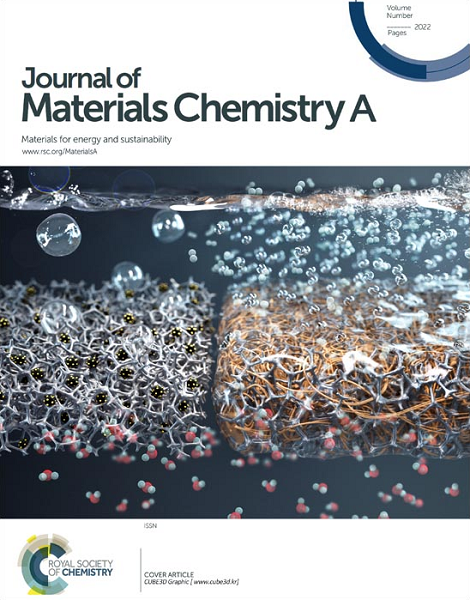低二氧化碳传质促进甲醇和甲醛在酞菁钴上的电合成
IF 10.7
2区 材料科学
Q1 CHEMISTRY, PHYSICAL
引用次数: 0
摘要
以碳纳米管为支撑的酞菁钴(CoPcCNT)通常催化二氧化碳(CO2RR)电还原为一氧化碳,但也有一些报道表明会形成甲醇。在此,我们通过分析 CoPc 负载和二氧化碳分压对 CO2RR 的影响,发现较低的二氧化碳传质到每个 CoPc 的速率有利于甲醇的形成,而较高的二氧化碳传质速率则有利于 CO 的演化。甲醇和 CO 的产生率之比与 CO2 的平均传质率呈负指数幂函数关系。因此,只有当二氧化碳进料供应量较低时,才能形成甲醇。补充实验和计算模型也支持这种传质效应,它们表明 CO 与 CoPc 的结合力比 CO2 弱,这与之前的研究结果一致。因此,*CO 只有在 CO2 供应量少、CO 停留时间长的情况下才能还原成甲醇。我们进一步为甲醇选择性催化剂的设计提供了定量指导。在总电流密度为 -19 mA cm-2 时,当 -0.86 V 对 RHE 时,增强的 CO 传质可促进 CORR 转化为甲醇,法拉第效率高达 70%。从 CO 到甲醇的反应中间产物甲醛的生成也得到了促进,法拉第效率高达 7%。我们将含有 Co(I)的 CoPc 确定为活性 CO2RR 位点。本文章由计算机程序翻译,如有差异,请以英文原文为准。
Low CO2 Mass Transfer Promotes Methanol and Formaldehyde Electrosynthesis on Cobalt Phthalocyanine
Cobalt phthalocyanine supported on carbon nanotubes (CoPcCNT) usually catalyzes the electroreduction of CO2 (CO2RR) to CO, although several reports have also indicated methanol formation. Herein, by analyzing the effects of CoPc loading and CO2 partial pressure on CO2RR, we show that a lower rate of CO2 mass transfer to each CoPc favors methanol formation, while a higher rate of CO2 mass transfer favors CO evolution. The ratio of the production rates of methanol and CO is related to the average CO2 mass transfer rate by a power function with a negative exponent. Hence, methanol can only be formed when the supply of CO2 feed is low. This mass transfer effect is supported by supplementary experiments and computational modelling, which show that CO binding to CoPc is weaker than that of CO2, in agreement with previous works. Consequently, *CO may only be reduced to methanol when the supply of CO2 is low and the dwelling time of CO is long. We further provide a quantitative guideline for the design of methanol-selective catalysts. At -0.86 V vs. RHE, enhanced CO mass transfer boosts CORR to methanol with a Faradaic efficiency up to 70 % at a total current density of -19 mA cm-2. The production of formaldehyde, a reaction intermediate from CO to methanol, is also boosted with a Faradaic efficiency of up to 7 %. We pinpoint CoPc containing Co(I) as the active CO2RR site.
求助全文
通过发布文献求助,成功后即可免费获取论文全文。
去求助
来源期刊

Journal of Materials Chemistry A
CHEMISTRY, PHYSICAL-ENERGY & FUELS
CiteScore
19.50
自引率
5.00%
发文量
1892
审稿时长
1.5 months
期刊介绍:
The Journal of Materials Chemistry A, B & C covers a wide range of high-quality studies in the field of materials chemistry, with each section focusing on specific applications of the materials studied. Journal of Materials Chemistry A emphasizes applications in energy and sustainability, including topics such as artificial photosynthesis, batteries, and fuel cells. Journal of Materials Chemistry B focuses on applications in biology and medicine, while Journal of Materials Chemistry C covers applications in optical, magnetic, and electronic devices. Example topic areas within the scope of Journal of Materials Chemistry A include catalysis, green/sustainable materials, sensors, and water treatment, among others.
 求助内容:
求助内容: 应助结果提醒方式:
应助结果提醒方式:


